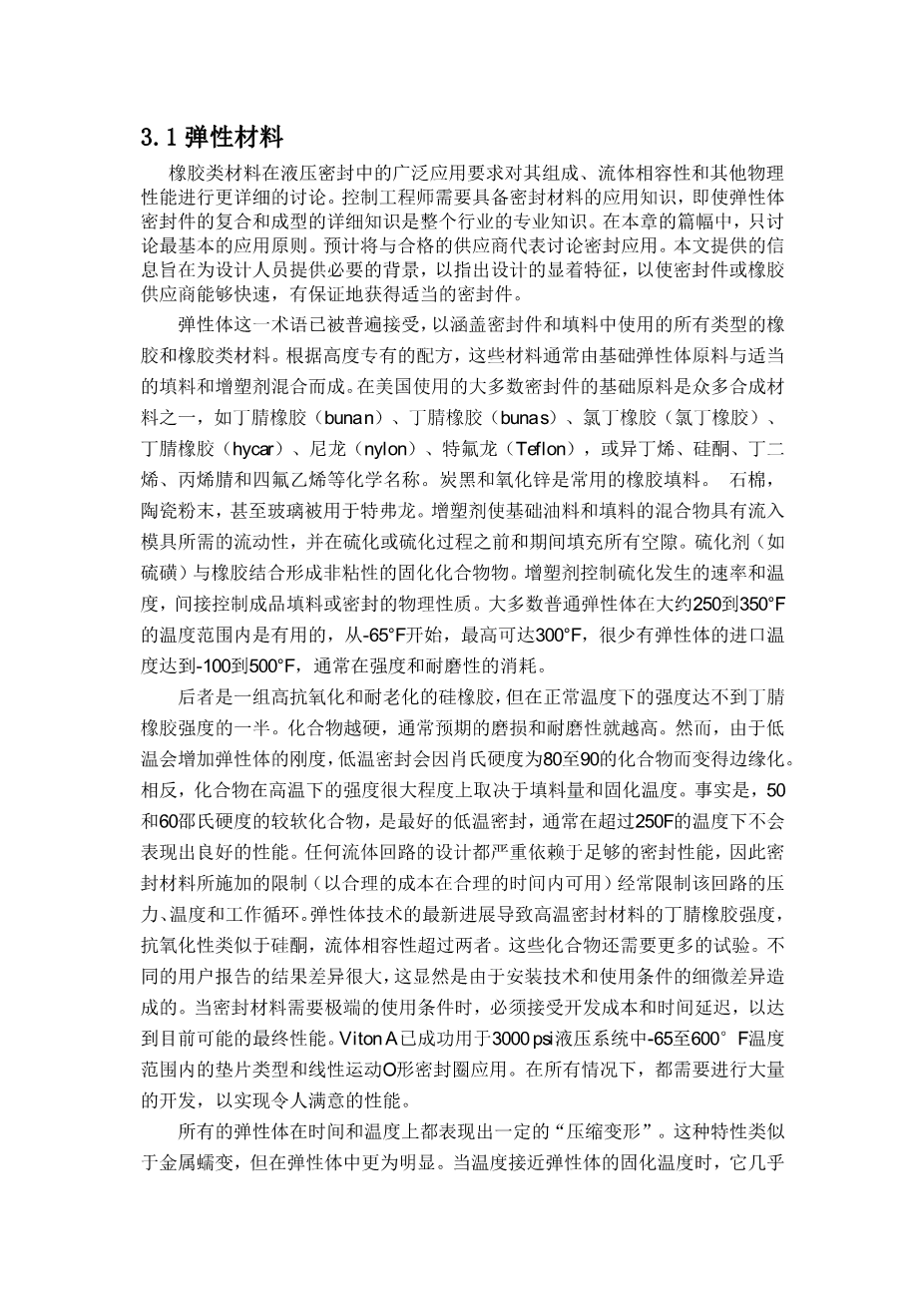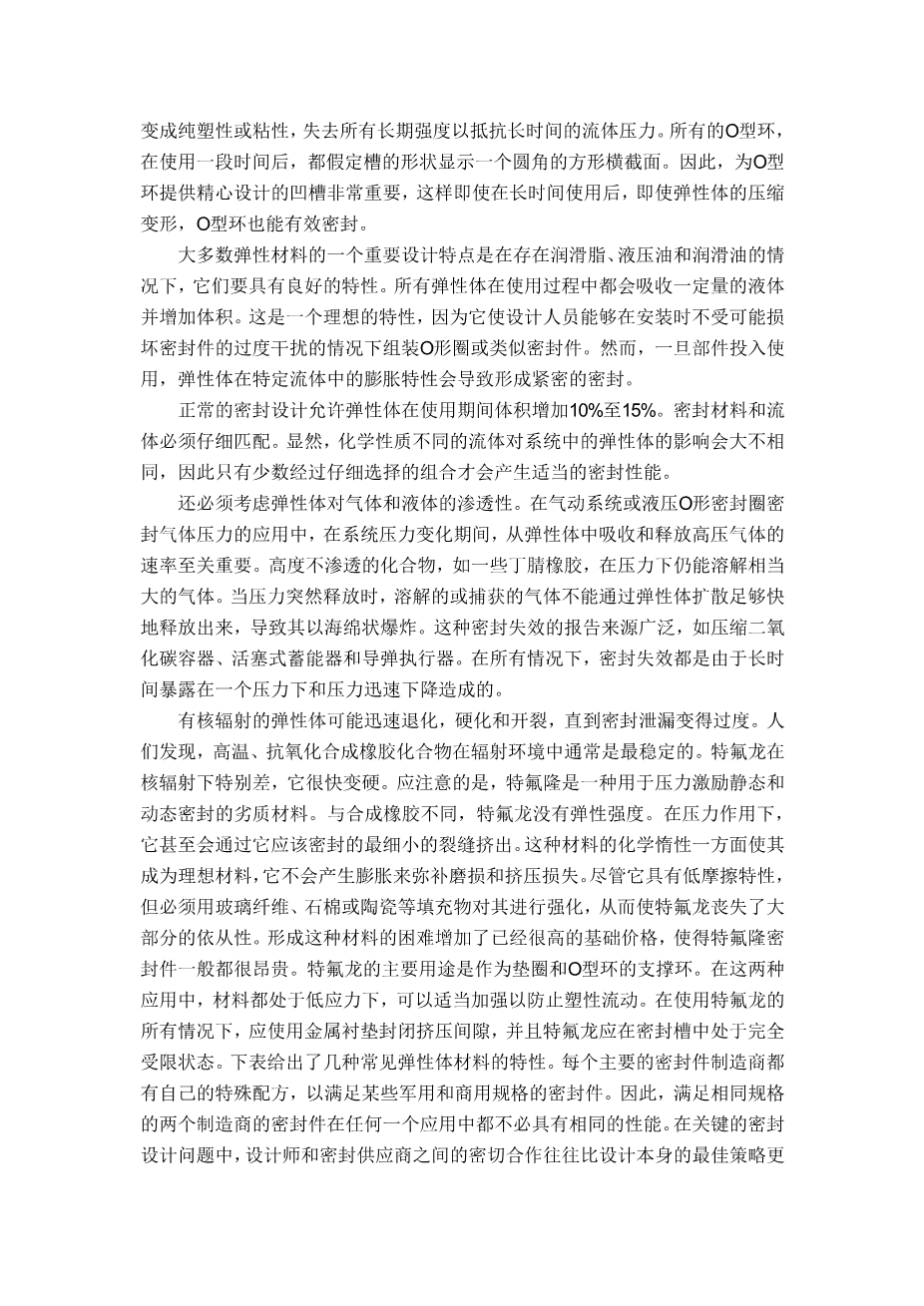3.1. ELASTOMERIC MATERIALS
The widespread use of rubberlike materials in hydraulic seals calls for a more detailed discussion of their composition, fluid compatibility, and other physical properties. The control engineer needs a working knowledge of the seal materials even though the detailed knowledge of compounding and forming of the elastomer seals is the specialty of an entire industry. In the space of this chapter only the most basic application principles will be discussed. It is expected that seal applications will be discussed with competent suppliers#39; representatives. The information presented here is intended to give the designer the necessary back-ground to point out salient characteristics of the design to allow the seal or rubber supplier to arrive at proper answers with speed and assurance.
The term elastomer is becoming generally accepted to cover all types of rubber and rubberlike materials used in seals and packings. These materials are usually compounded from the base elastomer stock with appropriate fillers and plasticizers according to highly proprietary recipes. The base stock for most seals used in the United States is one of the numerous synthetics known by such trade names as buna N, buna S, neoprene, Hycar, nylon, Teflon, or by such chemical designations as isobutylene, silicone, butadiene, acrylonitrile, and tetrafluoroethylene. Carbon black and zinc oxide are commonly used fillers for rubber. Asbestos, ceramic powder, and even glass are used in Teflon. The plasticizers give the mixture of base stock and filler the fluidity it needs to flow into the mold and fill all voids prior and during the vulcanizing or curing process. Vulcanizing agents such as sulphur combine with the rubber to form nontacky cured compounds. The plasticizer controls the rate and temperature at which vulcanizing takes place and, indirectly, the physical properties of the finished packing or seal. Most of the common elastomers are useful over a temperature range of about 250 to350°F, starting at-65°F and going as high as 300°F.A very few have been eompounded to reach from-100 to 500°F, usually at the expensc of strength and wearresistance. Among the latter is the group of silicone rubbers which are highly oxidation-resistant and age-resistant but achieve less than one-half the strength of the buna N#39;s at normal temperatures. The harder a compound the more wear and abrasion resistance can normally be expected. Since the low temperatures, however, increase the stiffness of the elastomer, low-temperature sealing becomes marginal with the compounds of 80 to 90 Shore hardness. Conversely the high-temperature strength of a compound depends to a great extenton the amount of filler and the curing temperature. The result is that the softer compounds of 50 and 60 Shore hardness, which make the best low-temperature seals, usually do not exhibit good performance at temperatures exceeding 250F. The design of any fluid circuit depends so heavily on adequate seal performance that the limitations imposed by the seal materials, available at a reasonable cost, and in a reasonable time, frequently limit the pressures, temperatures, and duty cycle of that circuit. Recent advances in elastomer technology have resulted in high temperature seal materials of the strength of the buna N#39;s, the oxidation resistance similar to silicones, and fluid compatibility exceeding both. More experience must yet be gained with these compounds. Different users report widely varying results-apparently as a result of minor differences in installation techniques and service conditions. When extreme service conditions are demanded of a seal material, the cost of development and the time delay must be accepted to achieve the ultimate performance currently possible. Viton A has been successfully used in gasket-type and linear-motion O-ring seal applications at temperatures ranging from-65 to 600°F in 3000 psi hydraulic systems. In all cases considerable development was necessary to achieve satisfactory performance.
All elastomers exhibit a certain amount of #39;'compression set' with time and temperature. This characteristic is analogous to metal creep, but is by far more pronounced in elastomers. At temperatures approaching the curing temperature of the elastomer, it becomes almost purely plastic or viscous and loses all long-time strength to resist prolonged fluid pressure. All O rings, after some time in service, assume the shape of the groove showing a square cross section with rounded corners. It is therefore very important to provide the O ring with a carefully designed groove which will permit it to seal efficiently even after prolonged service and in spite of the compression set of the elastomer.
An important design feature of most elastomeric materials is their well characteristic in the presence of greases, hydraulic fluids, and lubricating oils. All elastomers absorb certain amounts of fluid and increase in volume during service. This is a desirable feature because it enables the designer to allow for assembly of O rings or similarly sealed parts without the excessive interference that might damage the seal upon installation. Once the component is in service, however, the swell characteristic of the elastomer in a particular fluid causes a tight seal to form.
Normal seal design allows for a 10 to 15 per cent volume increase of the elastomer during service. It is essential that the seal material and the fluid be carefully matched. Clearly, chemically different fluids will have vastly different effects on the elastomers in the system so that only a few carefully selected combinations will result in proper seal performance.
Elastomer permeability to gases and liquids also must be considered.
In a pneumatic system or in applications where a hydraulic O ring seals against gas pressure, the rate at which high-pressure gas is absorbed and released from the elastomer during pressure changes


英语原文共 8 页
资料编号:[3495]


